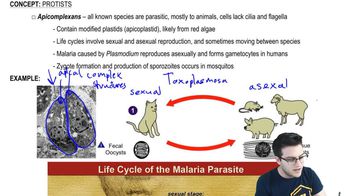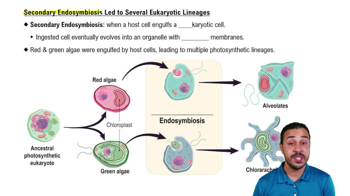Biologists think that endosymbiosis gave rise to mitochondria before plastids partly because a. the products of photosynthesis could not be metabolized without mitochondrial enzymes. b. all eukaryotes have mitochondria (or their remnants), whereas many eukaryotes do not have plastids. c. mitochondrial DNA is less similar to prokaryotic DNA than is plastid DNA. d. without mitochondrial CO2 production, photosynthesis could not occur.
Ch. 28 - Protists
Chapter 28, Problem 1
Plastids that are surrounded by more than two membranes are evidence of a. evolution from mitochondria. b. fusion of plastids. c. origin of the plastids from archaea. d. secondary endosymbiosis.
 Verified step by step guidance
Verified step by step guidance1
Identify the key term in the question: 'Plastids that are surrounded by more than two membranes'. This indicates a complexity in the structure of plastids.
Recall the concept of endosymbiosis in biology, which is a symbiotic relationship where one organism lives inside the other. Primary endosymbiosis involves the engulfment of a bacterium by a eukaryotic cell, leading to organelles like mitochondria and chloroplasts.
Understand that secondary endosymbiosis occurs when an already complex eukaryotic cell (that has undergone primary endosymbiosis) is engulfed by another eukaryotic cell. This results in the organelle being surrounded by more than two membranes.
Analyze the options given: (a) evolution from mitochondria, (b) fusion of plastids, (c) origin of the plastids from archaea, (d) secondary endosymbiosis. Only option (d) directly relates to the concept of an organelle being surrounded by more than two membranes due to the engulfment by another eukaryotic cell.
Conclude that the correct answer is (d) secondary endosymbiosis, as it explains why plastids would be surrounded by more than two membranes.

Verified Solution
Video duration:
1mWas this helpful?
Key Concepts
Here are the essential concepts you must grasp in order to answer the question correctly.
Plastids
Plastids are organelles found in the cells of plants and algae, responsible for various functions such as photosynthesis, storage, and the synthesis of other important molecules. They include chloroplasts, chromoplasts, and leucoplasts. The structure of plastids typically involves a double membrane, but some plastids can have additional membranes due to evolutionary processes.
Recommended video:
Guided course

Apicomplexans
Endosymbiotic Theory
The endosymbiotic theory posits that certain organelles, like mitochondria and plastids, originated from free-living prokaryotic organisms that were engulfed by ancestral eukaryotic cells. This theory explains the double membrane structure of these organelles, as they retain their own genetic material and machinery, resembling bacteria. Secondary endosymbiosis refers to a further engulfment event, leading to plastids with more than two membranes.
Recommended video:
Guided course

Endosymbiotic Theory
Secondary Endosymbiosis
Secondary endosymbiosis occurs when a eukaryotic cell engulfs another eukaryotic cell that already contains plastids. This process can result in plastids that are surrounded by multiple membranes, reflecting the original membranes of both the engulfed and the engulfing cells. This concept is crucial for understanding the diversity of plastids in various eukaryotic lineages, particularly in certain algae.
Recommended video:
Guided course

Secondary Endosymbiosis Led to Several Eukaryotic Lineages
Related Practice
Textbook Question
1251
views
Textbook Question
Which group is incorrectly paired with its description? a. diatoms—important producers in aquatic communities b. red algae—eukaryotes that acquired plastids by secondary endosymbiosis c. apicomplexans—unicellular parasites with intricate life cycles d. diplomonads—unicellular eukaryotes with modified mitochondria
904
views
Textbook Question
According to the phylogeny presented in this chapter, which protists are in the same eukaryotic supergroup as plants? a. green algae b. dinoflagellates c. red algae d. both A and C
489
views
